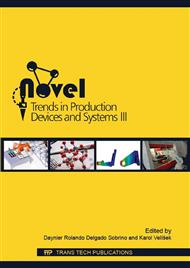[1]
P. Blaškovitš, et al., Cladding materials for abrasive and erosive wear, Welding. 11-12, (2001) 45-48.
Google Scholar
[2]
H. Czichos, Tribology. A Systems approach to the science and technology of friction, lubrication and wear. Tribology series, (1978).
DOI: 10.1016/s0167-8922(09)70003-3
Google Scholar
[3]
S. Chatterjee, T.K. Pal, Wear behavior of hardfacing deposits on cast iron, Wear 255 (2003) 417–425.
DOI: 10.1016/s0043-1648(03)00101-7
Google Scholar
[4]
P. Knoško, I. Kovaříková, E. Hodúlová, Procedure of developing a model to predict wear of friction layers. Scientific Work MtF STU Bratislava. 25 (2008), 83-88.
Google Scholar
[5]
P. Mohyla, J. Zemánek, Mig/Mag welding in a nutshell. Welding World. X, 1 (2006), 16-17.
Google Scholar
[6]
E. Hodúlová, R. Koleňák, M. Gatial, High-frequency surfacing and brazing, Layers and coatings. (2002), 95-99.
Google Scholar
[7]
P. K. Palani, N. Murungan: Optimization of weld bead geometry for stainless steel claddings deposited by FCAW, Journal of Materials Processing Technology, Volume 190, Issues 1–3, 23 July 2007, Pages 291–299.
DOI: 10.1016/j.jmatprotec.2007.02.035
Google Scholar
[8]
A. S. Syarul, I. A. Izatul, A. Amalina, A. Ghalib, The Effect of Flux Core Arc Welding (FCAW) processes on different parameters, Procedia Engineering 41 (2012) 1497 – 1501.
DOI: 10.1016/j.proeng.2012.07.341
Google Scholar
[9]
J. J. Coronado, H. F. Caicedo, A. L. Gomez: The effects of welding processes on abrasive wear resistance for hardfacing deposits, Tribology International 42 (2009) 745–749.
DOI: 10.1016/j.triboint.2008.10.012
Google Scholar
[10]
M.F. Buchely, J.C. Gutierrez, L.M. Leon, A. Toro, The effect of microstructure on abrasive wear of hardfacing alloys, Wear 259 (2005) 52–61.
DOI: 10.1016/j.wear.2005.03.002
Google Scholar
[11]
M. Turňa, M. Sahul, K. Demianová, Surfacing of metallic powders with laser, Metal. (2011) 1-6.
Google Scholar
[12]
J. Ondruška, M. Turňa, M. Sahul, Welding of lead to steel with explosion. Technology forum. (2011), 51-56.
Google Scholar
[13]
M. Turňa, J. Ondruška, Z. Turňová, Explosion Cladding of Lead on Steel, Acta Polytechnica. 3 (2012), 51-56.
DOI: 10.14311/1570
Google Scholar
[14]
M. Marônek, R. Lazar, M. Dománková, Low-carbon sheet metals treated by nitrooxidation in fluid layer and their properties, Scientific Bulletin. XXI (2007), 461-466.
Google Scholar
[15]
P. Mohyla, V. Foldyna, Importance of tempering welded joints on creep resistant steels. Metal. (2007) 1-10.
Google Scholar
[16]
I. Kovaříková, B. Szewczyková, P. Blaškovitš, E. Hodúlová, E. Lechovič, Study and characteristic of abrasive wear mechanisms. Materials Science and Technology. 1 (2009), 1-8.
Google Scholar


